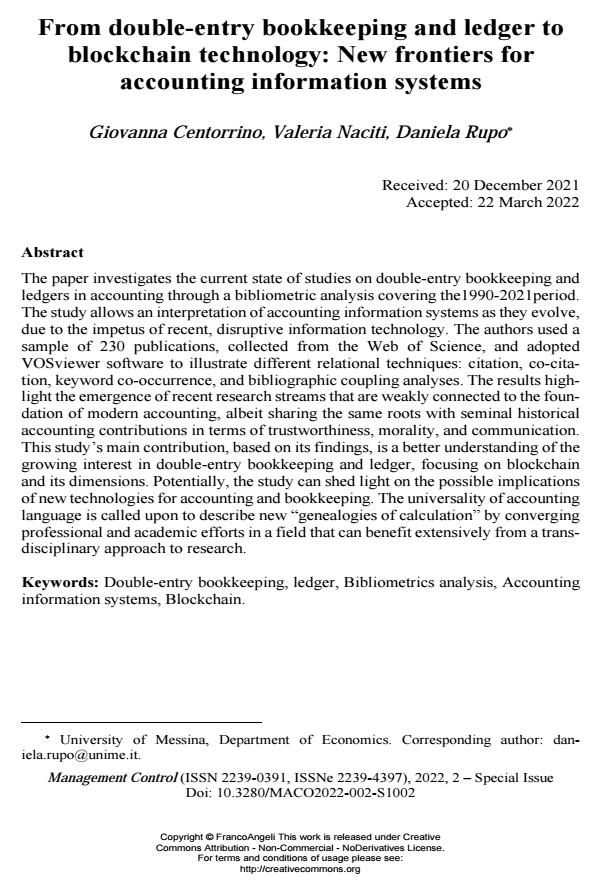From double-entry bookkeeping and ledger to blockchain technology: New frontiers for accounting information systems
Titolo Rivista MANAGEMENT CONTROL
Autori/Curatori Giovanna Centorrino, Valeria Naciti, Daniela Rupo
Anno di pubblicazione 2022 Fascicolo 2022/2 Suppl.
Lingua Inglese Numero pagine 27 P. 15-41 Dimensione file 388 KB
DOI 10.3280/MACO2022-002-S1002
Il DOI è il codice a barre della proprietà intellettuale: per saperne di più
clicca qui

FrancoAngeli è membro della Publishers International Linking Association, Inc (PILA)associazione indipendente e non profit per facilitare (attraverso i servizi tecnologici implementati da CrossRef.org) l’accesso degli studiosi ai contenuti digitali nelle pubblicazioni professionali e scientifiche
The paper investigates the current state of studies on double-entry bookkeeping and ledgers in accounting through a bibliometric analysis covering the1990-2021period. The study allows an interpretation of accounting information systems as they evolve, due to the impetus of recent, disruptive information technology. The authors used a sample of 230 publications, collected from the Web of Sci-ence, and adopted VOSviewer software to illustrate different relational techniques: citation, co-citation, keyword co-occurrence, and bibliographic coupling analyses. The results highlight the emergence of recent research streams that are weakly connected to the foundation of modern accounting, albeit sharing the same roots with seminal historical accounting contributions in terms of trustworthiness, moral-ity, and communication. This study’s main contribution, based on its findings, is a better understanding of the growing interest in double-entry bookkeeping and ledg-er, focusing on blockchain and its dimensions. Potentially, the study can shed light on the possible implications of new technologies for accounting and bookkeeping. The universality of accounting language is called upon to describe new "genealo-gies of calculation" by converging professional and academic efforts in a field that can benefit extensively from a transdisciplinary approach to research.
Parole chiave:Double-entry bookkeeping, ledger, Bibliometrics analysis, Accounting information systems, Blockchain.
- Blockchain implications for the accounting realm: A critique of extant studies Rosanna Spanò, Maurizio Massaro, Adele Caldarelli, Carlo Bagnoli, in MANAGEMENT CONTROL 1/2023 pp.21
DOI: 10.3280/MACO2023-001002 - Does non-financial information matter? Mapping and clustering literature on the value relevance of comprehensive disclosure Daniela Rupo, Nicola Rappazzo, Salvatore Loprevite, Giovanna Centorrino, in MANAGEMENT CONTROL 2/2024 pp.89
DOI: 10.3280/MACO2024-002005 - Intelligenza artificiale e accounting: le possibili relazioni Diego Valentinetti, Michele A. Reaa, in MANAGEMENT CONTROL 2/2023 pp.93
DOI: 10.3280/MACO2023-002005 - Management control in inter-firm relationships: Opportunities and challenges of blockchain technology adoption Giovanna Centorrino, Guido Noto, Daniela Rupo, in MANAGEMENT CONTROL 3/2022 pp.65
DOI: 10.3280/MACO2022-003004 - Extending the boundaries of financial reporting in the extractive industries: Insights from bibliometric analysis Giovanna Centorrino, Valeria Naciti, Daniela Rupo, in Corporate Social Responsibility and Environmental Management /2025 pp.563
DOI: 10.1002/csr.2967
Giovanna Centorrino, Valeria Naciti, Daniela Rupo, From double-entry bookkeeping and ledger to blockchain technology: New frontiers for accounting information systems in "MANAGEMENT CONTROL" 2 Suppl./2022, pp 15-41, DOI: 10.3280/MACO2022-002-S1002